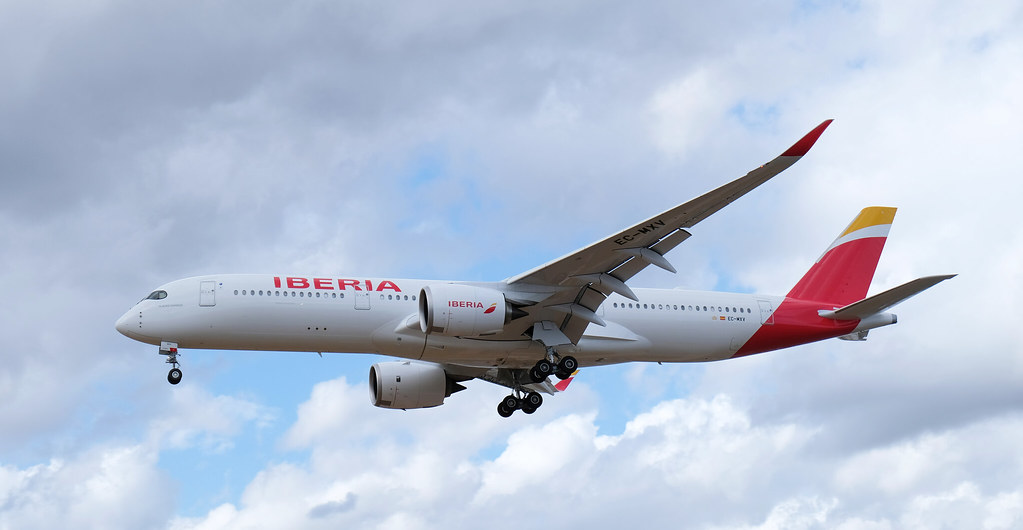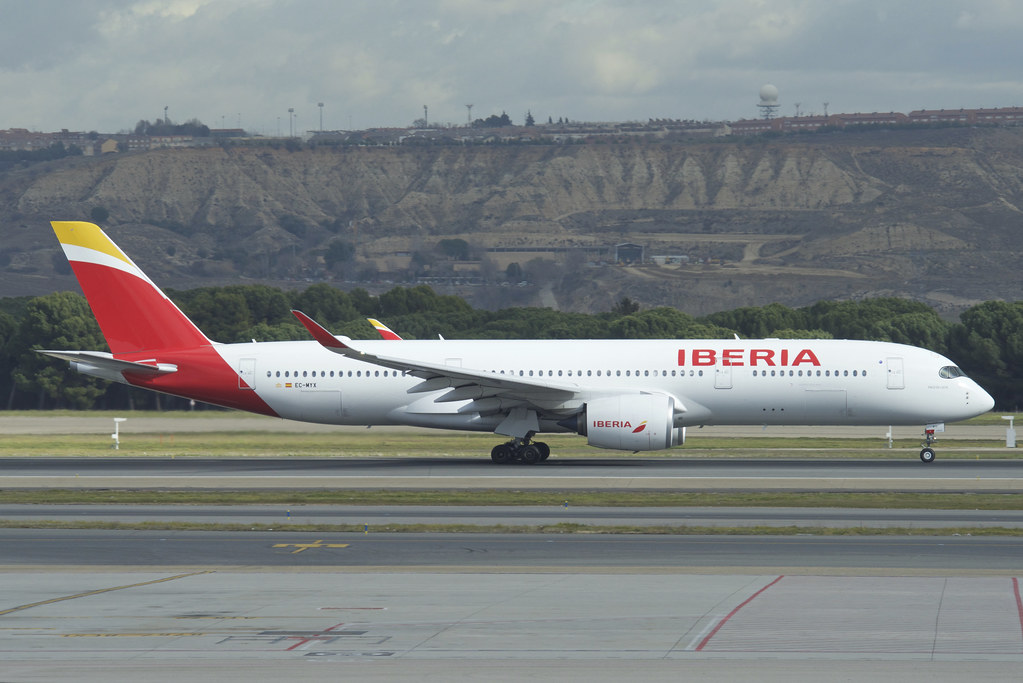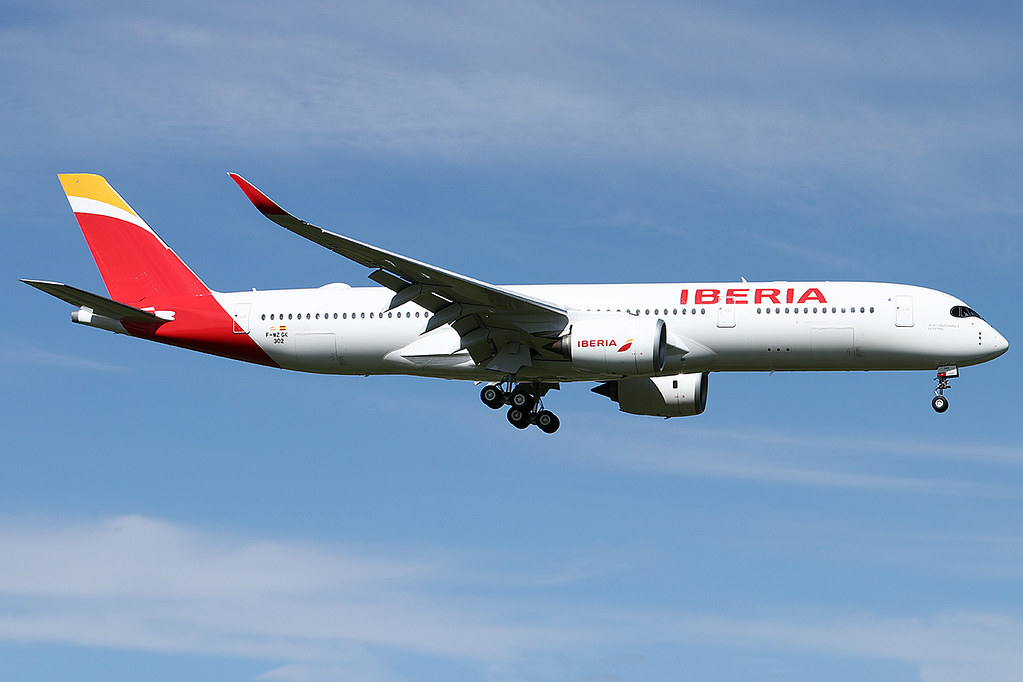Iberia Fleet Airbus A350-900 Details and Pictures. On current fleet, Iberia operates 6 wide-body aircraft Airbus A350-900, with 2 more on orders.
The A350 is a latest-generation aircraft equipped with state-of-the-art technology and designed to save fuel, therefore reducing the environmental impact.
It also offers multiple benefits for passengers, such as wider aisles, larger overhead bins, an air-conditioning system that enhances on-board comfort by providing fresher air, panoramic windows, and much more.
Currently used on the New York route, as from February 2019 it will gradually be phased in for the Buenos Aires route, so that by the end of the year we’ll be using it for one of our daily flights between Spain and Argentina.

Airbus A350-900 Iberia Aircraft Fleet Data and Registration Number
| Reg | Aircraft | Delivered | Name |
| EC-MXV | Airbus A350-900 | Jun 2018 | Plácido Domingo |
| EC-MYX | Airbus A350-900 | Jul 2018 | Paco de Lucia |
| EC-NBE | Airbus A350-900 | Jan 2019 | Museo del Prado |
| EC-NCX | Airbus A350-900 | Apr 2019 | Selección Española de Fútbol |
| EC-NDR | Airbus A350-900 | May 2019 | Juan Sebastian Elcano |
| EC-NGT | Airbus A350-900 | Nov 2019 | Equipo Olímpico Español |
Iberia Fleet Airbus A350-900 Cabin Interior Class Configuration and Seats Layout
Iberia’s A350-900 aircraft is outfitted with 31 Business Class, 24 Premium Economy and 293 Economy Class seats.
Featuring a 1-2-1 staggered configuration, this layout offers moderate privacy for window seats and centre pairs, but none for anyone seated by the aisles.
Couples will enjoy the cosy centre pairs, whereas fans of window seats will prefer odd-numbered A and L seats for “true” window views.
Iberia have chosen a colour scheme which is completely grey, white and beige throughout.
As a result, the cabin is characterless and insipid.
Red and yellow are not premium brand colours, but Iberia should have really given thought to making at least a splash of colour in the cabin.
A red feature wall with logo, or even a red stripe or writing on the headrests would go a long way to alleviating the disappointing monochrome in business class.
Iberia’s cabin is the least inspiring of any major carrier – first impressions count.
The seat is fully lie-flat and adjustable in intermediate positions.
The tray table, once deployed, is fixed, but the seat will move forward if you cannot reach it.
IFE touch screens are responsive and a fair size, and the choices inoffensive and middle-of-the-road. The moving map is interactive and perspective can be manipulated.
Storage was good and thoughtfully placed, and two USB points and a universal socket ensure you won’t run out of battery.
An interesting foible of this seat is that the “bed” doesn’t properly meet the ottoman.
There’s a gap of around 1.5 inches, so your feet will slightly hang off the ledge.
Seat Map and Seating Chart Airbus A350-900 Iberia

Economy Cabin
The economy cabin is configured with 34 rows of (mostly) 3-3-3 seating, divided across two cabins.
The forward economy cabin contains rows 21 through 37, and the rear economy cabin continues from row 38 through 54.
Rows are spaced with 30 inches of pitch.
After measuring this, I started preparing myself for a long flight with my knees against the seat in front of me.
Surprisingly, there was enough legroom for my 5 foot, 11 inch frame, possibly thanks to a lumbar curve built into the seats.
Seats measured 18 inches between armrests with 19-inch-wide seat cushions.
While this certainly wasn’t spacious, it was a critical inch more than what’s found on Boeing 787 Dreamliners when configured in the common 3-3-3 arrangement or Boeing 777s when configured in the increasingly standard 3-4-3 arrangement.
Seat headrests could be adjusted vertically by up to 6 inches, and the sides could be folded inward to create a cradle for your head for more comfortable sleeping.
The seatbacks have two storage areas.
There’s a literature-only pouch measuring 13 inches wide and a couple inches deep just beneath the IFE screen.
While partly filled with Iberia magazines, there was enough room for passengers to store passports, boarding passes, phones and other small items.
Below this pouch is a 12-inch-wide standard seatback pocket.
Thanks to the literature pouch, this pocket only contained the safety card and an air-sickness bag but was otherwise free for passenger storage.
To fit the literature pouch, the tray table is a bifold design, measuring 15.5 inches wide by 9 inches deep fully extended.
The table extends a critical 1.5 inches, making working on a small laptop possible when the seat in front of me wasn’t reclined.
(Thankfully the passenger in front of me didn’t recline at all during the flight… not all heroes wear capes.)
The only exception to the 3-3-3 seating arrangement is the exit row at the front of the rear economy cabin (Row 38) and the last row in the back of the rear economy cabin (Row 54).
In both of these places, the window-side sections have only two seats instead of three.
The missing window seat in Row 38 creates two seats with extra legroom: 39A and 39L.
They have the benefits of a window, lots of legroom and aisle access.
Seats 21A through C and J through L also have plenty of legroom because there’s no bulkhead between the premium-economy cabin and economy.
Bassinet mounts were only in the middle seats at the front of each cabin (Row 21 and Row 38).
There are six bathrooms in total for the 293 economy-class seats: four between the economy cabins and two in the rear of the aircraft.
Besides the galley in the front of the premium-economy cabin and the galley in the rear of the aircraft, there was no way of switching from one side of the aircraft to the other.
And flight attendants snapped the galley curtains closed to try to prevent visitors from doing that.
So passengers had to use the bathrooms on their side of the aircraft — unless they wanted to risk irritating the flight attendants.
The middle seats in rows 49 through 53 have significantly lower overhead bins and head space because of the crew rests built in above these seats.
If you struggle to get your bags in the overhead bin, you may want to select seats in this area of the cabin.
While the headroom was fine for seated passengers, the reduced height could lead passengers to hit their heads when crossing the middle seats.
Business Cabin
The very gray business-class cabin is home to 32 lie-flat seats arranged in a 1-2-1 configuration.
My seat was 2A, a solo seat on the port side of the cabin.
Every other seat was closer to the window, with the others nearer to the aisle.
If you’re traveling alone in the middle section of two seats, you’ll want to select the even rows, as you’ll have more privacy from the passenger next to you.
If you’re traveling as a couple, on the other hand, select the odd rows so you’ll be closer together.
The seat was operated by controls on the side, which gave me different options all the way from an upright seat to fully lie-flat and everywhere in between.
When turned into a bed, the seat was comfortable, with a medium-size pillow and lightweight blanket.
Airbus A350-900 Iberia Aircraft Fleet Inflight Amenities and On-Board Services Information
- Audio. The audio selections for both Business, Premium Economy and Economy Class offer 200 music channels.
- Video. All classes offer individual TV screens with more than 50 films in different languages and close to 80 choices for TV series and documentaries.
- AC Power. All seats in Business Class have a 110v AC power outlet. Seats in Premium Economy and Economy have power outlets located in between the seats. All seats on this aircraft also have access to a USB port at their seat.
- Internet. Iberia provides Wi-Fi on this airplane.
- Food. On long-haul flights, all classes are offered complimentary meals.
Iberia Aircraft Fleet Wide-Body Airbus A350-900 Images Gallery
Seat Map and Seating Chart Airbus A350 900 Iberia Iberia EC MXV Airbus A350 941 Plácido Domingo on finals into London Heathrow runway 27L as IB3166 from Madrid IBERIA Airbus A350 900 EC MYX Paco de Lucia at MAD Madrid Barajas Airport Iberia Airbus A350 941 EC NBE Museo del Prado at Tolouse Airport Iberia Airbus A350 941 EC NCX Selección Española de Fútbol
Thanks to visiting AirlinesFleet.com and read article : Iberia Fleet Airbus A350-900 Details and Pictures.


